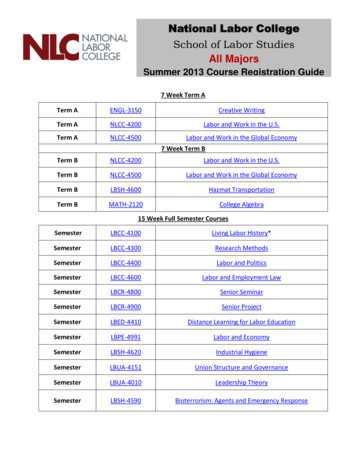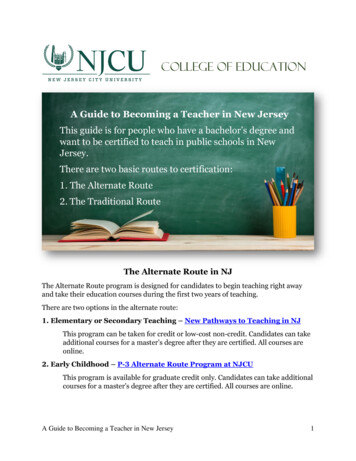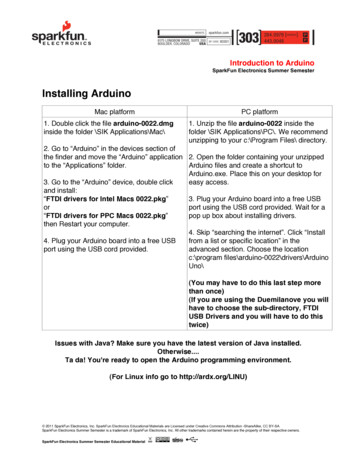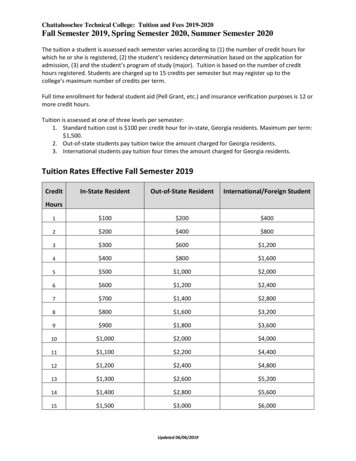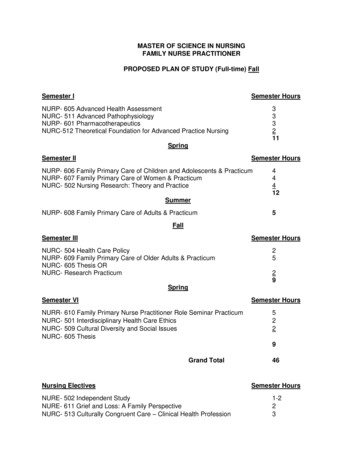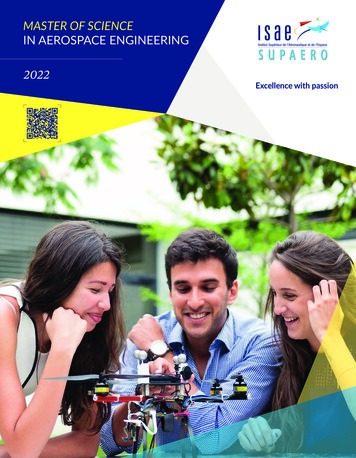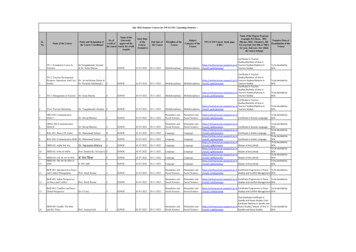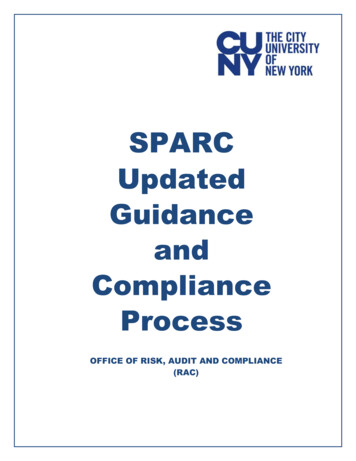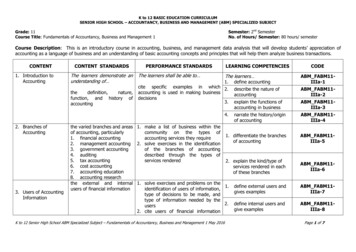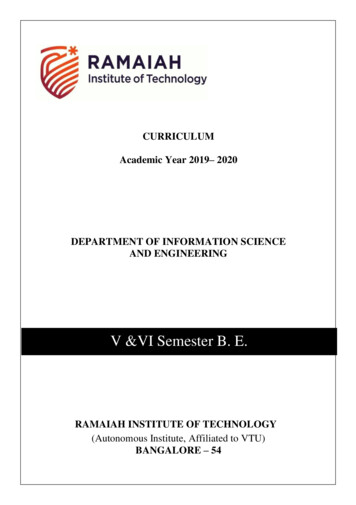
Transcription
CURRICULUMAcademic Year 2019– 2020DEPARTMENT OF INFORMATION SCIENCEAND ENGINEERINGV &VI Semester B. E.RAMAIAH INSTITUTE OF TECHNOLOGY(Autonomous Institute, Affiliated to VTU)BANGALORE – 54
About the lyknownasM.S.RamaiahInstituteofTechnology) is a self-financing institution established in Bangalore in the year1962 by the industrialist and philanthropist, Late Dr. M S Ramaiah. The institute isaccredited with “A” grade by NAAC in 2014 and all engineering departmentsoffering bachelor degree programs have been accredited by NBA. RIT is one o f thefew institutes with prescribed faculty student ratio and achieves excellent academicresults. The institute was a participant of the Technical Education QualityImprovement Program (TEQIP), an initiative of the Government of India. All thedepartments have competent faculty, with 100% of them being postgraduates ordoctorates. Some of the distinguished features of RIT are: State of the artlaboratories, individual computing facility to all faculty members. All researchdepartments are active with sponsored projects and more than 304 scholars arepursuing PhD. The Centre for Advanced Training and Continuing Education(CATCE), and Entrepreneurship Development Cell (EDC) have been set up oncampus. RIT has a strong Placement and Training department with a lyequippedSportsdepartment,large urnals like IEEE, JET etc. RIT is a member of DELNET, and AICTE INDESTConsortium. RIT has a modern auditorium, several hi-tech conference halls and allare air-conditioned with video conferencing facilities. It has excellent hostelfacilities for boys and girls. RIT Alumni have distinguished themselves byoccupying high positions in India and abroad and are in touch with the nedAcademicAutonomyforallitsUGand PG programs in the year 2007. As per the National Institutional RankingFramework, MHRD, Government of India, Ramaiah Institute of Technology hasachieved 64th rank in 2019 among the top 100 engineering colleges acrossIndia.2
About the Department:Information Science and Engineering department is established in the year 1992 withan objective of producing high-quality professionals to meet the demands of theemerging field of Information Science and Engineering. Department also startedM.Tech program in Software Engineering in the year 2004 and has been recognized asR&D center by VTU in 2012. The department is accredited by the NBA in 2001, 2004,2010, 2015 and reaccredited in 2018 under Tier-1 till 2021. Department has highlyqualified and motivated faculty members, and well equipped state of the artlaboratories. All faculty members are involved in research and technical paperspublications in reputed journals, conferences across the world. Strong collaborationwith industries and high profile institutions is in place for curriculum updates, morehands on training, practical‟s, project based learning, expert lectures, partial coursedeliveries by industry experts and student interns to enhance the skills in emergingareas to keep an oppressive academic environment. Department is successfullyconducting seminars, conferences and workshops for students and academicians in theemerging areas of Information Technology. Some of the laboratories have also been setup in collaboration with industries such as Intel, Microsoft, Apple, SECO, Honeywell,EMC2, NVIDIA and IBM. Also, an echo system is built to initiate start-ups at thedepartment level along with the mentorship. All the above potential activities have ledto high profile placements, motivation to become an entrepreneur, and encouragementfor higher learning.3
VISION OF THE INSTITUTETo be an Institution of International Eminence, renowned for imparting qualitytechnical education, cutting edge research and innovation to meet global socioeconomic needsMISSION OF THE INSTITUTEMSRIT shall meet the global socio-economic needs through Imparting quality technical education by nurturing a conducive learningenvironment through continuous improvement andcustomization Establishing research clusters in emerging areas in collaboration withglobally reputedorganizations repreneurialactivities and consultancy for socio-economicneedsQUALITY POLICYWe at MS Ramaiah Institute of Technology strive to deliver comprehensive,continually enhanced, global quality technical and management education throughan established Quality Management System complemented by the synergisticinteraction of the stake holders concernedVISION OF THE DEPARTMENTTo evolve as an outstanding education and research center of Information Technology tocreate high quality Engineering Professionals for the betterment of SocietyMISSION OF THE DEPARTMENT To provide a conducive environment that offers well balanced Information Technologyeducation and research. To provide training and practical experience in fundamentals and emergingtechnologies. To nurture creativity for overall personality development.4
PROGRAM EDUCATIONAL OBJECTIVES (PEOs)PEO1: Become competent Information Technology professionals with continuous progressin career or learning.PEO2: Enhance the skills in developing computing systems using modern tools andtechnologies.PEO3: Function effectively as professionals in a team environment or individually.PROGRAM OUTCOMES (POs)PO1: Engineering knowledge: Apply the knowledge of mathematics, science,engineering fundamentals, and an engineering specialization to the solution ofcomplex engineering problems.PO2: Problem analysis: Identify, formulate, review research literature, andanalyze complex engineering problems reaching substantiated conclusions usingfirst principles of mathematics, natural sciences, and engineeringsciences.PO3: Design/development of solutions: Design solutions for complexengineeringproblems and design system components or processes that meet the specified needswith appropriate consideration for the public health and safety, and the cultural,societal, and environmentalconsiderations.PO4: Conduct investigations of complex problems: Use research-basedknowledge and research methods including design of experiments, analysis andinterpretation of data, and synthesis of the information to provide valid conclusions.PO5: Modern tool usage: Create, select, and apply appropriate techniques,resources, and modern engineering and IT tools including prediction and modelingto complex engineering activities with an understanding of the limitations.PO6: The engineer and society: Apply reasoning informed by the contextualknowledge to assess societal, health, safety, legal and cultural issues and theconsequent responsibilities relevant to the professional engineering practice.PO7: Environment and sustainability: Understand the impact ofthe professionalengineering solutions in societal and environmental contexts, and demonstrate theknowledge of, and need for sustainable development.5
PO8: Ethics: Apply ethical principles and commit to professional ethics andresponsibilities and norms of the engineering practice.PO9: Individual and team work: Function effectively as an individual, and as amember or leader in diverse teams, and in multidisciplinary settings.PO10: Communication: Communicate effectively on complex engineeringactivities with the engineering community and with society at large, such as, beingable to comprehend and write effective reports and design documentation, makeeffective presentations, and give and receive clear instructions.PO11: Project management and finance: Demonstrate knowledge andunderstanding of the engineering and management principles and apply these toone‟s own work, as a member and leader in a team, to manage projects and inmultidisciplinary environments.PO12: Life-long learning: Recognize the need for, and have the preparation andability to engage in independent and life-long learning in the broadest context oftechnological change.PROGRAM SPECIFIC OUTCOMES (PSOs)PSO1: Problem Solving Skills, ability to understand and analyze the InformationTechnology problems and develop computer programs.PSO2: Applied Engineering Skills, ability to apply standard practices and strategiesinSoftware Development.PSO3: Communication and Higher Learning, ability to exchange knowledge andcontinuelearning advances in the field of Information Technology.6
Curriculum Course Credits DistributionBatch 2019-20SemesterFirstSecondThirdHumanities& SocialSciences(HSS)BasicSciences/ hFifthSixthSeventh2ProfessionalCoursesCore (Hardcore, softcore, Lab)(PC-C)1821191514ProfessionalCourses 166Totalsemesterload2523252525252626200
SCHEME OF TEACHINGV SEMESTERSl.No.CourseCodeCourse Name8.ISL58Computer NetworksOperations ResearchOperating SystemsDatabase Management SystemsIntellectual Property RightsComputer Networks LaboratoryDatabase Management SystemsLaboratoryScripting Languages Laboratory9.ISEAXElective oryNatural Language ProcessingISEA3Embedded Computing C-E41901040104250429Elective TitleDigital Image ve A:Elective CodeISEA1Credits8
SCHEME OF TEACHINGVI STotalContactHoursSystem SoftwareObject Oriented Analysis and DesignIS62A/62BPatterns using C /JAVAJava and C-C30010403PW00600612System Software LaboratoryObject Oriented Analysis and DesignPatterns LaboratoryJava and J2EE ourse NameElective BTotalElective B:Elective CodeISEB1ISEB2Elective TitleMachine LearningCompiler DesignISEB3ISEB4Distributed Storage TechnologiesComputer Graphics9
V SemesterCOMPUTER NETWORKSCourse Code: IS51Credit: 4:0:0:0Prerequisite: Data CommunicationsContact Hours: 56LCourse Coordinator: Dr. Siddesh G MCourse Content:UNIT-INetwork layer: Logical addressing - IPV4addresses, Address space, Notations,Classful addressing, Classless addressing, Network Address Translation;IPV6addresses,Structure and Address Space.Networklayer:Internetprotocol-IPV4 datagram,fragmentation, checksum, options; IPV6 packet format, advantages, ddress mapping, Error reporting & Multicasting-Address mapping, Logical tophysical address - ARP, Physical to Logical address - RARP, BOOTP and DHCP;Internet Control Message Protocol (ICMP), Internet Group Management Protocol(IGMP). Network layer: Delivery, Forwarding, & Routing – Direct Vs Indirectdelivery, Forwarding Techniques, Forwarding Process, Routing Table; Unicast RoutingProtocols – Optimization, Intra and Inter Domain Routing, Distance Vector Routing,Link State Rout Routing, Path Vector Routing.UNIT-IIIMulticast Routing Protocols – Introduction to Unicast, Multicast, Broadcast and Anycast, applications, Unicast Routing Vs Multicast Routing, Source Based Tree Routing,Group Shared Tree Routing, Multicast Link State Routing, Multicast Distance Vector,CBT, MBONE. Transport Layer - Process-to-Process Delivery, User DatagramProtocol, Transmission Control Protocol, SCTP-services and features.UNIT-IVCongestion control & QOS - Data traffic, Congestion, Congestion control, TwoExamples – Congestion control in TCP and Frame Relay, Quality of Service, Techniquesto improve QOS. Application Layer: Domain Name System -Namespace, Domainname space, Distribution of Name space, DNS in internet, Resolution. Case study: QoSRequirements In Portable Devices.10
UNIT-VRemote logging – TELNET; Electronic mail – Architecture, User Agent, MessageTransfer Agent: SMTP; File transfer - File transfer protocol (FTP). NetworkManagement: SNMP - Network management system; Simple Network ManagementProtocol – concept, management components, structure of management information,Management information base, Lexicographic ordering, SNMP PDUs. Case study:Mobile Networks Applications.Text Book:1. Behrouz A. Forouzan, Data Communications and Networking, Fourth Edition, TataMcGraw-Hill, 2006.References:1. Alberto Leon-Garcia and Indra Widjaja, Communication Networks –FundamentalConcepts and Key architectures, Second Edition, Tata McGraw-Hill, 2004.2. William Stallings, Data and Computer Communication, Eight Edition, PearsonEducation, 2007.3. Larry L. Peterson and Bruce S. David, Computer Networks – A Systems Approach,Fourth Edition, Elsevier, 2007.Course Outcomes (COs):At the end of the course, students will be able to1.Identify and solve the problems associated with transition from IPV4 to IPV6.(PO-1,2,3) (PSO-1,2)Use different protocols to achieve Address mapping, Error reporting and unicast2.routing. (PO-1,2,3)(PSO-1)Paraphrase multicast routing and distinguish between different transport layer3.protocols.(PO- 1, 2) (PSO-2)Analyze different techniques to improve QoS and illustrate domain namespace4.resolution.(PO- 1,2,3)(PSO-2, 3)Illustrate the working of various application layer services like Remote login, E5.mail, FTP, SNMP and simple network management protocol. (PO- 2, 12) (PSO-2,3)11
OPERATIONS RESEARCHCourse Code: IS52Prerequisite: NilContact Hours: 42L 14TCourse Coordinator: Mr.Rajaram M GowdaCredit: 3:1:0:0Course Content:UNIT-IIntroduction to Operations Research (OR) and Linear Programming (LP): ORModels, Solving the OR Model, Phases of an OR Study; Modeling with LinearProgramming (LP), Two-variable LP Model, Graphical LP solution, Solution of aMaximization/Minimization Model; Computer solution with Excel Solver; LP Modelin Equation Form, Transition from Graphical to Algebraic Solution;; TORA ToolUNIT-IIThe Simplex Method: The Simplex Method ,Special cases in the Simplex Method,Degeneracy, Alternative optima, Unbounded solutions, Non-existing solutions;Artificial Variable Techniques: Two Phase Method, Big-M method; TORA ToolUNIT-IIIDuality and Game Theory: Introduction: Concept of Duality; Definition of PrimalDual Problems; General Rules for Converting any Primal into its Dual; Introductionto Dual Simplex Method; Computational Procedure of Dual Simplex Method;Illustrative Examples. Introduction of Game Theory, Characteristics of GamesTheory; Minimax ( Maximin) Criterion and Optimal Strategy; Saddle Point, OptimalStrategies and the value of game; Solution of Games with Saddle Point(s);Rectangular Games without Saddle Point; Arithmetic Method for (2x2) Games,Gambit tool for Game theory.UNIT-IVProject Management by PERT-CPM: Introduction, Applications of PERT/CPMTechniques, Basic Steps in PERT/CPM Techniques; Network Diagramrepresentation, Rules for Drawing Network Diagram, LabelingFulkerson‟s „I-J‟ Rule; Time Estimates and Critical Path in Network Analysis; ProjectEvaluation and Review Technique, TORA tool.12
UNIT-VTransportation and Assignment Problems: Mathematical Formulation oftransportation problem (TP); Matrix Form of TP; Feasible Solution, Basic FeasibleSolution and Optimum Solution; Tabular Representation; Special Structure ofTransportation Table and their Problems; Initial Basic Feasible Solution to TP;Moving Towards Optimality; Degeneracy in TP; Unbalanced TP; MathematicalFormulation of Assignment Problem (AP); Fundamental Theorems; HungarianMethod for AP; TORA tool.Tutorial Exercises:1. Problems on Formulation of Linear Programming Problems,2. Problems on Graphical Solutions to Linear Programming Problems3. Problems on Simplex Method4. Problems on special cases in simplex method5. Problems on Two Phase Method6. Problems on Big-M Method7. Problems on Dual Simplex Method8. Problems on CPM9. Problems on PERT10. Problems on Game theory11. Problems on Transportation Problems12. Problems on Assignment ProblemsText Books:1.2.Operations Research: An Introduction – Hamdy A Taha – 9th Edition, PearsonEducation, India, 2011.Operations Research – S.D. Sharma – 16th Edition, KNRN Publications, 2009.Reference:1.Introduction to Operations Research – Frederick S. Hillier and Gerald J.Lieberman – 9th Edition, Tata McGraw Hill,200913
Course Outcomes (COs):At the end of the course, students will be able toFormulate and solve linear programming model using graphical method.1(PO-1, 2,3,5) (PSO- 1, 2)2345Solve a linear programming model using simplex methods (PO-1, 2, 3, 5)(PSO-1, 2)Apply game theory to model, analyze and solve real-world problems.(PO-1, 2, 3, 5) (PSO-1, 2)Analyze a project network using PERT and CPM techniques. (PO-1, 2, 3, 5)(PSO-1, 2)Solve Transportation and assignment problems. (PO-1, 2, 3, 5) (PSO-1, 2 )14
OPERATING SYSTEMSCourse Code: IS53 Credit: 3:0:0:0Prerequisite: NilContact Hours: 42LCourse Coordinator: Mrs. Pushpalatha M NCourse Content:UNIT-IIntroduction: Operating System Structure, Operating System Operations, ProcessManagement, Memory Management, Storage Management, Protection and Security;Process Concept: Process Scheduling, Operations on Processes, InterprocessCommunication; Process Scheduling: Scheduling Criteria, Scheduling algorithmsMultiple processor scheduler.UNIT-IISynchronization: The Critical Section Problem, Peterson‟s Solution, SynchronizationScheduling Algorithms, Multiple-Processor Scheduling Hardware, Semaphores, ClassicalProblems of Synchronization, Monitors, Synchronization Examples; Deadlocks: SystemModel, Deadlock Characterization, Methods for handling Deadlocks, DeadlockPrevention, Deadlock Avoidance and detection, Recovery from Deadlock.UNIT-IIIMemory Management Strategies: Background, Swapping, Contiguous MemoryAllocation, Paging, Structure of Page Table, Segmentation; Virtual Memory Management:Background, Demand Paging, Copy on Write, Page Replacement, Allocation of frames,Allocating Kernel Memory.UNIT-IVFile System: File Concept, Access Methods, Directory Structure, Protection;Implementing File Systems: File System Structure, File System Implementation,Directory Implementation, Allocation Methods, Free Space Management, Efficiency andPerformance, Recovery; Secondary-Storage Structure: Disk structure, Disk Attachment,Disk Scheduling Methods, Disk management, Swap-Space Management.UNIT-VSystem Protection: Goals of Protection, Principle of Protection, Access Matrix, Domainof Protection, Access Matrix and its implementation, Case Study on The Linux System:Design Principles, Kernel Modules, Process Management, Scheduling, Memory15
Management File Systems, Interprocess Communication.Text Book:1. Silberschatz, Galvin, Gagne, Operating System Concepts, 7/e, John Wiley and sons,2007.References:1. Dhamdhere D. M., Operating Systems, A Concept Based Approach, 2/e, TataMcGraw Hill, 2006.2. Tanenbaum A. S., Modern Operating Systems, 3/e, Pearson Education, 2008.Course Outcomes (COs):At the end of the course, students will be able to1. Discuss operating system concepts and analyze CPU scheduling algorithms.(PO- 1,2,3) (PSO-1,2)2. Describe the various methods for accessing shared data and handling deadlocks.(PO-1,2,3) (PSO-1,2)3. Employ the techniques for memory management during process execution.(PO-1,2,3) (PSO-1,2)4. Describe the file system and secondary storage structure.(PO-1,2,3) (PSO-1,2)5. Articulate the need for information protection mechanisms in OS and illustrate theworking of modern operating system. (PO –1,2) (PSO-1,2)16
DATABASE MANAGEMENT SYSTEMSCourse Code: IS54Credit: 3:0:0:1Prerequisite: Fundamentals ofComputing LaboratoryContact Hours:42LCourse Coordinator: Mrs.Lincy Meera MathewsCourse Content:UNIT-IIntroduction: Characteristics of Database approach: Advantages of using DBMSapproach, Data models, Schemas and Instances; Three-schema architecture and dataindependence: Database languages and interfaces; Classification of DatabaseManagement systems; Using High-Level Conceptual Data Models for Database Design;An Example Database Application: University Database, Railway Managementdatabase, Airways databaseSelf-Study: MongoDB –Overview, Advantages, Environment,UNIT-IIEntity Types, Entity Sets, Attributes and Keys; Relationship types, Relationship Sets,Roles and Structural Constraints; Weak Entity Types; Refining the ER Design; ERDiagrams, Relational Model Concepts; Relational Model Constraints and RelationalDatabase Schemas;Update Operations, Transactions and dealing with constraintviolations.Self-Study:MongoDB:Data Modelling,Create database,Drop database, create collection,Drop collection AlterUNIT-IIIUnary Relational Operations: SELECT and PROJECT; Relational Algebra Operationsfrom Set Theory; Binary Relational Operations: JOIN and DIVISION; AdditionalRelational Operations, Relational Database Design Using ER- to-Relational Mapping,Informal Design Guidelines for Relation Schemas; Functional Dependencies; NormalForms Based on Primary Keys-1NF, 2NF,3NF, BCNF.Self-Study:MongoDB: Data Types,Insert,Update , Querying Database,Projection, SortingDatabase.UNIT-IVSQL Data Definition and Data Types; Specifying basic constraints in SQL; Schemachange statements in SQL; Basic queries in SQL; More complex SQL Queries. Insert,Delete and Update statements in SQL; Views (Virtual Tables) in SQL. PL/SQL: Data17
types in PL/SQL, Control statements (IF, LOOP, WHILE, FOR), Cursor, PassingParameter to Cursor, Implicit Cursor, Exceptions, Procedures and functions.Self-Study:MongoDB: Aggregation, Replication.UNIT-VIntroduction to Transaction Processing, Transaction and System Concepts, Desirableproperties of Transactions, Characterizing Schedules Based on Recoverability,Characterizing Schedules Based on Serializability, Transaction Support in SQL; Twophase Locking Techniques for concurrency Control, Concurrency Control based onTimestamp Ordering, Recovery concepts, Recovery techniques based on Deferred Update,Recovery techniques based on Immediate Update, Shadow paging, The ARIES recoveryalgorithm.Self-Study: MongoDB: Sharding and Create BackupText Books:1. Ramez Elmasri and Shamkant B.Navathe: Fundamentals of Database Systems, 5thEdition, Addison-Wesley, 2007.2. Benjamin Rosenzweig, Elena Silvestrova Rakhimov : Oracle PL/SQL by Example, 4thEdition, 2010.3. https://www.tutorialspoint.com/mongodb/mongodb rialReferences:1. Silberschatz, Korth and Sudharshan: “Data base System Concepts, Fifth Edition, McGrawHill, 2006”.2. Raghu Ramakrishnan, Johannes Gehrke, “Database Management Systems, ThirdEdition”, McGraw-Hill, 2003.3. Kyle Banker Peter Bakkum Shaun Verch Douglas Garrett Tim Hawkins“MongoDB Action 2nd Edition”Course Outcomes (COs):At the end of the course, students will be able to1.Utilize the basic Database concepts and design ER model for any DatabaseApplication. (PO- 1, 2, 3, 9, 10, 12) (PSO- 2, 3)2.Convert ER model to Relational model. (PO- 3, 9, 10, 12) (PSO- 1, 2 ,3)3.Design a relational database schema by applying normalization procedure for anydatabase application (PO- 1, 3, 9, 10, 12) (PSO-1,2,3)4.Design and develop a real world database application (PO- 1, 3, 9, 10, 12)(PSO-1,2,3)5.Utilize the concepts of Transaction processing, concurrency control, recoverytechniques to appreciate the database transactions. (PO- 1, 12) (PSO- 2)18
INTELLECTUAL PROPERTY RIGHTSCourse Code: IS55Credit: 2:0:0:0Prerequisite: NilContact Hours: 28LCourse Coordinator: Mrs.Evangeline DCourse Content:UNIT-IIntroduction: Meaning, Relevance, Business Impact, Protection of IntellectualProperty, Copyrights, Trademarks, Patents, Designs, Utility Models, Trade Secrets andGeographical Indications Bio-diversity and IPR Competing Rationales for Protection ofIntellectual Property Rights, Introduction to the leading International Instrumentsconcerning Intellectual Property Rights: the Berne Convention, Universal CopyrightConvention, The Paris Convention, Patent Co-operation Treaty, TRIPS, The WorldIntellectual Property Organization(WIPO).UNIT-IIPatents: Concept of Patent, Product / Process Patents & Terminology, Duration ofpatents Law and Policy Consideration Elements of Patentability - Novelty and NonObviousness (Inventive Steps and Industrial Application, Non- Patentable SubjectMatter Procedure for Filing of Patent Application and types of Applications, Procedurefor Opposition, Revocation of Patents, Ownership and Maintenance of Patents,Assignment and licensing of Patents, Working of Patents- Compulsory Licensing,Patent Database and Information Systems, Preparation of Patent documents, Process forExamination of Patent Application, Patent InfringementUNIT-IIITrademarks - The rationale of protection of trademark for commercial and ofconsumer rights , Definition and concept of Trademarks , Different kinds of marks(brand names, logos, signatures, symbols, well known marks, certification marks andservice marks), Non Registrable Trademarks Procedure for Registration of Trademarks,Opposition Procedure, Assignment/Transmission / Licensing of Trademarks,Infringement of Trademarks.UNIT-IV19
Copyright- Nature of Copyright, Works in which Copyrights subsist, Author &Ownership of Copyright Rights Conferred by Copyright Assignment, Transmission,Licensing of Copyrights Infringement of Copyrights Remedies & Actions forInfringement of Copyrights Copyright Societies, Office, Board, Registration ofCopyrights & Appeals International Conventions Copyright pertaining toSoftware/Internet and other Digital Media Remedies.UNIT-VIPR in the Field of Information Technology. Recent Developments in Patent System,Subject matter of software design law definition, subject matter Law relating toembedded software design and registration in India, Infringement of software designrights. Technological and Legal Developments in Intellectual Property, IP inCyberspace.Text Books:1. Dr. B. L. Wadhera, Law Relating to Intellectual Property, Universal lawPublishing Co. Ltd. 2009.2. Aswani Kumar Bansal, Law of Trademarks in India.References:1. Intellectual Property Rights, Handbook/Notes.2. Course materials for one year P.G. Diploma in IPR from NLSIU, Bangalore byMr. T. Ramakrishna.3. Case studies from internet sources.Course Outcomes (COs):At the end of the course, students will be able to1. Identify the principles of Intellectual Property Rights and its importance in thefield of Information Technology. (PO-6,8)(PSO-3)2. Analyze the importance of patents, trademarks and copyrights.(PO-6,8)(PSO- 3)3.Describe the procedure for obtaining a patent, registering a trademark and owningcopyrights. (PO-6,8)(PSO-3)20
COMPUTER NETWORKS LABORATORYCourse Code: ISL56Credit: 0:0:1:0Prerequisite: Data CommunicationsContact Hours: 14PCourse Coordinator:Mr.Sandeep B LCourse Content:Part A: Implement the following using C/C :1. Using TCP/IP sockets, write a client-server program to make client send thefile name and the server to send back the contents of the requested file name“sample.txt” with the following contents:”Hello we are at Computer NetworksLab”. Display suitable error message in case the file is not present in theserver.2. Write a program to archive Traffic management at Flow level byimplementing Leaky Bucket Algorithm.3. Given a graph, each node A knows the shortest path to node Z and node A candetermine its shortest path to Z by calculating the minimum cost. Now whenpacket flows through a path it incurs some cost to the network, find shortestpaths from src to all nodes in the given graph using Bellman Ford Algorithm.The graph may contain negative weight edges.4. Given a graph find shortest paths from source to all nodes in the graph usingDijkstra‟s shortest path algorithm.5. Write a program for implementing the error detection technique for datatransfer in unreliable network code using CRC (16-bits) Technique.6. Write a program to implement internet checksum for error correction anddetection.7. Packets from different flows arrive at a switch or router for processing. Agood scheduling technique treats the different flows in a fair and appropriatemanner. Implement priority queuing as a technique to improve Quality ofService.Part B: Simulation Using NS-21. Simulate three nodes point-to-point networks with duplex links between them.Set the queue size and vary the bandwidth and find the number of packetsdropped2. Simulate the different types of internet traffic such as FTP and TELNET overnetwork and analyze the throughput3. Simulate a four-node point-to-point network, and connect the links as follows:n0- n2, n1- n2 and n2- n3. Apply TCP agent changing the parameters and21
4.5.6.determine the number of packets sent/received by TCP/UDPSimulate the transmission of ping messages over a network topologyconsisting of 6 nodes and find the number of packets dropped due tocongestion.Simulate an Ethernet LAN using n nodes and set multiple traffic nodes anddetermine collision across different nodes.Simulate an Ethernet LAN using n nodes (6-10), change error rate and datarate and compare throughput.Text Book:1. Behrouz A. Forouzan, Data Communications and Networking, FourthEdition, Tata McGraw-Hill, 2006.Course Outcomes (COs):At the end of the course, students will be able to1.Design and implement the functionalities of various layers of the OSI model. (PO– 3, 4) (PSO – 2)2.Simulate and analyze the network behavior against various parameters usingNS2. (PO – 1, 2, 3, 4, 5) (PSO – 2)22
DATABASE MANAGEMENT SYSTEMS LABORATORYCourse Code: ISL57Credit: 0:0:1:0Prerequisite: Fundamentals of Computing LaboratoryContact Hours: 14PCourse Coordinator: Mr.Prashanth KambliCourse Content:The Database Management Systems Lab consists of two components: Part A and Part B.One exercise from each is compulsory.Part AI.Execute the following exercises1. Consider the rela
Classful addressing, Classless addressing, Network Address Translation;IPV6addresses, Structure and Address Space. . Delivery, Forwarding, & Routing - Direct Vs Indirect delivery, Forwarding Techniques, Forwarding Process, Routing Table; Unicast Routing Protocols - Optimization, Intra and Inter Domain Routing, Distance Vector .
